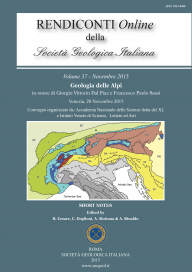
From mineralogy to petrology: the example of diamond and its inclusions
Paolo Nimis (a), Ross J. Angel (a), Matteo Alvaro (b) & Fabrizio Nestola (a)
(a) Department of Geosciences, University of Padua, via Gradenigo, 6, 35131, Padua, Italy. Corresponding email: paolo.nimis@unipd.it
(b) Department of Earth and Environmental Sciences, University of Pavia, via Ferrata, 1, 27100, Pavia, Italy.
DOI: https://doi.org/10.3301/ROL.2015.174
Volume: 37/2015
Pages: 47-49
Abstract
Inclusion-host systems may record information on the mode of growth and on physical conditions at the time of entrapment. Evidence for syngenesis (= the inclusion precipitated together with its host) or protogenesis (= the inclusion pre-existed its host) can sometimes be achieved from the determination of the crystallographic orientations of the inclusions relative to their hosts. Measurement of residual pressures on the inclusions can be used to calculate the entrapment pressures based on elasticity theory. This type of information can be particularly relevant in studies of diamonds in kimberlites, but can provide useful constraints also for the correct interpretation of P–T paths in metamorphic rocks. For instance, the presence of inclusions only of the low-P polymorph of silica in a stiff mineral such as garnet does not necessarily imply that the rock did not experience UHP conditions. Also, a residual pressure on diamond inclusions in garnet cannot be explained by elastic processes alone and suggests that the inclusion-host system have reset at high-T by some other type of mechanism, e.g., by plastic deformation of the host.
Keywords
Get Full Text